Our life mission is to educate people all over the world about the ancient wisdom of the Siddhas of India. Tara and I came to India in 2006 specifically to study this ancient body of knowledge. For the next four years we researched the lives of great Siddha saints who attained the pinnacle of human evolution. The word “Siddha” in Sanskrit means “perfected one” or “one who has attained the perfection of consciousness.” We feel that it is vital for the survival of mankind to understand these great masters because they demonstrate to us what we all can become, both as Self-Realized individuals and collectively as an enlightened humanity.
In June of 2011 we were invited to make a pilgrimage to a 13,000 foot tall mountain in far northern India where twelve great Siddhas had lived and where there are caves where highly advanced yogis still meditate. In addition, this mountain is famous for being a place where Mahavatar Babaji frequently visits and the local people have many stories of encounters with him.
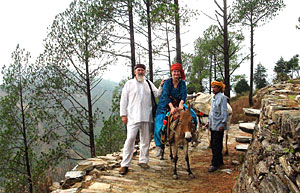 The mountain is very remote. It took us two days on foot and horseback to reach the summit of the 13,000 foot mountain. This is Land of the Siddhas; pristine nature, rarefied atmosphere, pure mountain streams, friendly spiritually devoted people. It’s the closest place we’ve discovered to Shangri-la.
The mountain is very remote. It took us two days on foot and horseback to reach the summit of the 13,000 foot mountain. This is Land of the Siddhas; pristine nature, rarefied atmosphere, pure mountain streams, friendly spiritually devoted people. It’s the closest place we’ve discovered to Shangri-la.
During our five years in India, we’ve been to a lot of beautiful places, visited many sacred temples and met many wonderful masters but this pilgrimage was the pinnacle of our time in India. When we finally reached the summit, we felt that we had reached Heaven on Earth and we prayed to the Great Masters of the Himalayas to bless us to bring the Wisdom of the Siddhas to the entire world.
The following is the story of our pilgrimage to the Land of the Siddhas.
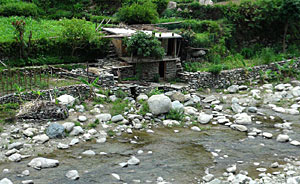 On our way to the mountain we stopped to eat lunch at a pujari’s house on the opposite side of the river. The only way to get there was to cross the river, either by wading across or walking on stones. That presented a problem, since we were traveling with our friend Dr. Varma, who is eighty years old. I was unsure if he could cross the river or if he would even want to. To my surprise he was up for it and crossed the river with ease.
On our way to the mountain we stopped to eat lunch at a pujari’s house on the opposite side of the river. The only way to get there was to cross the river, either by wading across or walking on stones. That presented a problem, since we were traveling with our friend Dr. Varma, who is eighty years old. I was unsure if he could cross the river or if he would even want to. To my surprise he was up for it and crossed the river with ease.
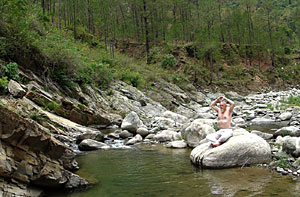 I enjoyed a swim in the river that happened to be refreshingly cool but not too cold considering that these rivers come from the Himalayas. After the swim I practiced Surya Yoga as we learned it from our Kriya guru, Yogiraj Gurunath Siddhanath.
I enjoyed a swim in the river that happened to be refreshingly cool but not too cold considering that these rivers come from the Himalayas. After the swim I practiced Surya Yoga as we learned it from our Kriya guru, Yogiraj Gurunath Siddhanath.
Our friends made us a delicious lunch from local organic vegetables and then we explored the nearby hills. The area was extremely beautiful. Narrow trails zigzagged their way up the terraced hillsides. I was struck by the realization that the people here had worked these hills generation after generation in order to make every available square foot of land as productive as possible. 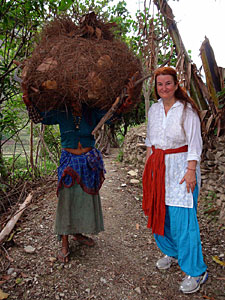 These mountain people are far removed from modern city life. They are very simple people, living close to nature. As we climbed higher and higher, local women passed us on the trail carrying huge loads on their heads.
These mountain people are far removed from modern city life. They are very simple people, living close to nature. As we climbed higher and higher, local women passed us on the trail carrying huge loads on their heads.
Our plan had been to spend the night at the pujari’s house but it was clear when we arrived that the house was far too primitive for us to be comfortable. It was actually a mill house where they ground flour. So now, we had to find a place to spend the night and again had to cross the river. This time, Dr. Varma chose to cross by walking over the stones. I was very happy when we reached the other side and helped him to climb the hillside to the road.
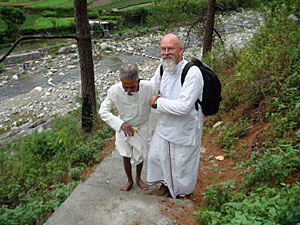 The pujari’s sons helped us find a guesthouse in the village. The guesthouse was really just an unfinished bare room above a restaurant with a concrete floor and no beds. There wasn’t even a lightbulb. Our friends ran to get us many blankets to sleep on and, yes, a lightbulb. At this point, we were happy to just have shelter for the evening. As the sun set over the mountains, we gazed at the mountain peaks and listened to the sound of the river down below. In the middle of the night, I went outside and sat on the rooftop gazing at the stars. I was hoping to see some shooting stars. Just when I was about to give up and go back to bed, Tara joined me and we saw a star streak across the sky. I made a wish that our journey the following day to the Land of the Siddhas would be successful.
The pujari’s sons helped us find a guesthouse in the village. The guesthouse was really just an unfinished bare room above a restaurant with a concrete floor and no beds. There wasn’t even a lightbulb. Our friends ran to get us many blankets to sleep on and, yes, a lightbulb. At this point, we were happy to just have shelter for the evening. As the sun set over the mountains, we gazed at the mountain peaks and listened to the sound of the river down below. In the middle of the night, I went outside and sat on the rooftop gazing at the stars. I was hoping to see some shooting stars. Just when I was about to give up and go back to bed, Tara joined me and we saw a star streak across the sky. I made a wish that our journey the following day to the Land of the Siddhas would be successful.
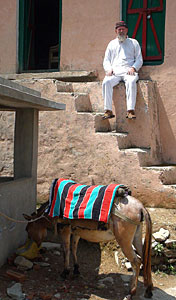 In the morning, we bid farewell to Dr. Varma who was going to stay at the guesthouse while we treked to the Land of the Siddhas. As we approached the 13,000 foot mountain, the peak was shrouded in clouds. We drove in a Jeep until the end of the road and then arranged for horses to ride to the top of the mountain. We hoped to make it to the summit in one day but the monsoon season was approaching which meant that rain was coming every afternoon and that could stop us from making it to the top of the mountain by nightfall.
In the morning, we bid farewell to Dr. Varma who was going to stay at the guesthouse while we treked to the Land of the Siddhas. As we approached the 13,000 foot mountain, the peak was shrouded in clouds. We drove in a Jeep until the end of the road and then arranged for horses to ride to the top of the mountain. We hoped to make it to the summit in one day but the monsoon season was approaching which meant that rain was coming every afternoon and that could stop us from making it to the top of the mountain by nightfall.
The horse wranglers arrived with a white horse for me and a cross between a mule and horse for Tara. It had been years since both of us had ridden but the wranglers assured us that the horses were very docile. 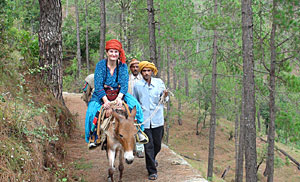 The trail started off fairly level but soon became steeper. The horses were amazingly sure-footed and negotiated the trail with great skill. At times the trail became very narrow and steep. Tara and I felt bad that the horses had to carry us, so periodically we dismounted to give the horse a break.
The trail started off fairly level but soon became steeper. The horses were amazingly sure-footed and negotiated the trail with great skill. At times the trail became very narrow and steep. Tara and I felt bad that the horses had to carry us, so periodically we dismounted to give the horse a break.
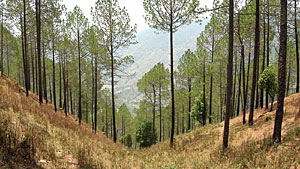 As we rose higher on the mountain, we passed through beautiful pine forests. After about an hour, while stopping for a rest, we ran into some local people on their way to a wedding. We were invited to join the wedding party and so when we reached where it was being held we joined in the festivities. We were the only foreigners there and, needless to say, we were the object of great curiosity.
As we rose higher on the mountain, we passed through beautiful pine forests. After about an hour, while stopping for a rest, we ran into some local people on their way to a wedding. We were invited to join the wedding party and so when we reached where it was being held we joined in the festivities. We were the only foreigners there and, needless to say, we were the object of great curiosity. 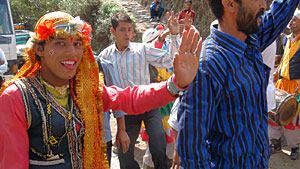 Earlier, when we were waiting for the horses, the band had arrived at the trail head. When they started playing, I joined in the dancing which greatly pleased the local people. Therefore, I had already established a rapport with them. I’ve heard since then that they are still saying how much they enjoyed my dancing.
Earlier, when we were waiting for the horses, the band had arrived at the trail head. When they started playing, I joined in the dancing which greatly pleased the local people. Therefore, I had already established a rapport with them. I’ve heard since then that they are still saying how much they enjoyed my dancing.
If you’ve never been to an Indian wedding, you might be surprised at some differences between how American couples and Indian couples act during the wedding and party afterwards. 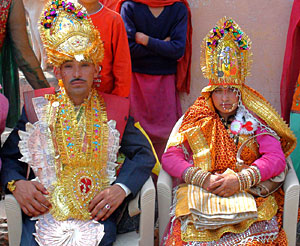 First of all, some Indian wedding can take a week. Also, traditionally, in the case of arranged marriages, the husband does not see the bride’s face until after the wedding is official. That’s a big difference right away. I’ve been to several Indian marriages and one thing that really surprised me was how serious the bride and groom seemed. I practically never saw them smile. When I asked why that was, a friend explained that they want to appear serious to show that they are mature enough to get married. Smiling or laughing would appear childish.
First of all, some Indian wedding can take a week. Also, traditionally, in the case of arranged marriages, the husband does not see the bride’s face until after the wedding is official. That’s a big difference right away. I’ve been to several Indian marriages and one thing that really surprised me was how serious the bride and groom seemed. I practically never saw them smile. When I asked why that was, a friend explained that they want to appear serious to show that they are mature enough to get married. Smiling or laughing would appear childish. 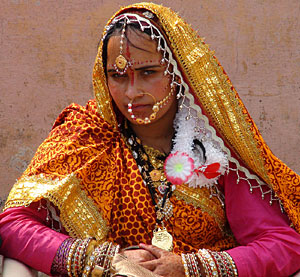 I thought of western weddings where the couple smiles and laughs practically all the time showing that they are happy that they are getting married. At a wedding in the west, if the couple never broke a smile, everyone would be talking about how unhappy they were to be getting married. In India, it’s a sign that they are mature enough to embark on a serious stage of life – the creation of a family. It’s just one of the many cultural differences.
I thought of western weddings where the couple smiles and laughs practically all the time showing that they are happy that they are getting married. At a wedding in the west, if the couple never broke a smile, everyone would be talking about how unhappy they were to be getting married. In India, it’s a sign that they are mature enough to embark on a serious stage of life – the creation of a family. It’s just one of the many cultural differences.
When we left the wedding party we felt a sense of urgency that we needed to get back on the trail so that we’d reach the summit before dark. However, nature had something else in store for us. No sooner had we resumed our climb than it began to rain and we had to turn back. 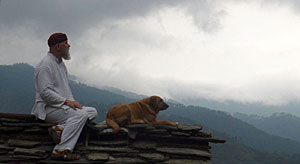 Fortunately, we were near the house of some friends of our guide and they invited us in to get out of the rain. I noticed that their dog, named Dhari, was sitting on the peak of the roof watching the dark storm clouds that were rolling in. I joined him on the roof and it looked like there was no way we’d be able to resume our climb that day. Soon a torrential downpour caused everyone to rush indoors and the power went out. We sat in the near dark and talked while the rain pelted the roof. It felt good to be with these mountain people who were simple, uncomplicated and sincere spiritually oriented Brahmins and we immediately established a friendship.
Fortunately, we were near the house of some friends of our guide and they invited us in to get out of the rain. I noticed that their dog, named Dhari, was sitting on the peak of the roof watching the dark storm clouds that were rolling in. I joined him on the roof and it looked like there was no way we’d be able to resume our climb that day. Soon a torrential downpour caused everyone to rush indoors and the power went out. We sat in the near dark and talked while the rain pelted the roof. It felt good to be with these mountain people who were simple, uncomplicated and sincere spiritually oriented Brahmins and we immediately established a friendship.
Tara and I soon learned that this community on the mountain doesn’t have a hospital and that many women die in childbirth because it’s a four hour drive through the mountains to the nearest hospital. Also, there’s no school for their children. Tara and I promised them that we would find a way to build a small hospital and school for them. If you are interested in helping with this, let us know.
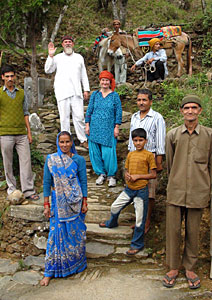 Our hosts provided us with a very nice bedroom, a cozy bed with lots of blankets, because it can get cold at night up on the mountain. As I fell asleep, I thought of how friendly these people are and how lucky they are to live in such a natural and pure environment. My heart felt great love for them and I made a vow to God that I would do everything I could to help them. We slept well after our first horseback ride in years and all the events of the day.
Our hosts provided us with a very nice bedroom, a cozy bed with lots of blankets, because it can get cold at night up on the mountain. As I fell asleep, I thought of how friendly these people are and how lucky they are to live in such a natural and pure environment. My heart felt great love for them and I made a vow to God that I would do everything I could to help them. We slept well after our first horseback ride in years and all the events of the day.
In the morning, our hosts fed us a wonderful breakfast and coffee while the horsemen prepared the horses. Several of the men offered to go with us to the top as guides. They were concerned that another storm might come in and we’d be caught in the downpour.
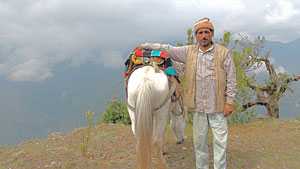 The trail got steeper and the view more spectacular. Finally, about a half hour from the summit, we dismounted to let the horses have a easier time climbing. We felt elated that in a short time we’d be at the top. We knew that this mounatain top had been a gathering place of great Siddha saints and that there very well could be great adepts living in the nearby caves.
The trail got steeper and the view more spectacular. Finally, about a half hour from the summit, we dismounted to let the horses have a easier time climbing. We felt elated that in a short time we’d be at the top. We knew that this mounatain top had been a gathering place of great Siddha saints and that there very well could be great adepts living in the nearby caves.
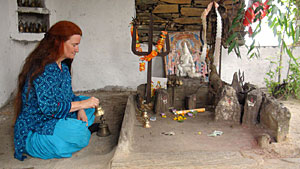 And then we reached the summit. Before us was a gate leading to the small primitive Siddha Temple. We removed our shoes because we were entering a sacred space, holy ground sanctified by the presence of great masters throughout the ages. Inside the temple was a statue of Shiva and many bells on shelves. Tara performed a ceremony in the Siddha Temple, invoking the Great Himalayan Masters, Siddhas, Saints and Sages of past, present and future to assist us in bringing the wisdom of the Siddhas to the people of the world.
And then we reached the summit. Before us was a gate leading to the small primitive Siddha Temple. We removed our shoes because we were entering a sacred space, holy ground sanctified by the presence of great masters throughout the ages. Inside the temple was a statue of Shiva and many bells on shelves. Tara performed a ceremony in the Siddha Temple, invoking the Great Himalayan Masters, Siddhas, Saints and Sages of past, present and future to assist us in bringing the wisdom of the Siddhas to the people of the world.
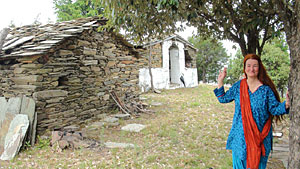 Then, we walked to the small kutir (hut) that the local people use when they come to the mounatin top to perfom pujas and celebrate religious festivals. Married couples also come here to spend the night and meditate after their wedding. The roof is totally broken down so now the roof leaks when it rains making it impossible for them to sleep there or keep food for the festivals. Tara and I offered to help them rebuild the kutir so that there traditions can be maintained.
Then, we walked to the small kutir (hut) that the local people use when they come to the mounatin top to perfom pujas and celebrate religious festivals. Married couples also come here to spend the night and meditate after their wedding. The roof is totally broken down so now the roof leaks when it rains making it impossible for them to sleep there or keep food for the festivals. Tara and I offered to help them rebuild the kutir so that there traditions can be maintained.
 We walked a few hundred feet along the crest. To the east was Nepal. To the north stretched the snow-covered Himalayan range. After the monsoons, when the sky is clear, you can see all the way across the Himalayas to Tibet. Nearby is one of the trekking routes to Mt. Kailas and Lake Manasarovar. It’s no wonder great Siddhas congregated at this place and why Mahavatar Babaji has been seen here.
We walked a few hundred feet along the crest. To the east was Nepal. To the north stretched the snow-covered Himalayan range. After the monsoons, when the sky is clear, you can see all the way across the Himalayas to Tibet. Nearby is one of the trekking routes to Mt. Kailas and Lake Manasarovar. It’s no wonder great Siddhas congregated at this place and why Mahavatar Babaji has been seen here.
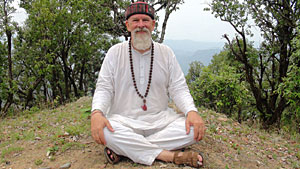 I sat on the very top of the summit, with an expansive view of the snow-covered Himalayan range and Tibet. Sitting in this holy place, sanctified by the Great Himalayan Masters, I prayed that the Light of their Wisdom enlighten the minds of humanity and fill everyone’s heart with Divine Love.
I sat on the very top of the summit, with an expansive view of the snow-covered Himalayan range and Tibet. Sitting in this holy place, sanctified by the Great Himalayan Masters, I prayed that the Light of their Wisdom enlighten the minds of humanity and fill everyone’s heart with Divine Love.
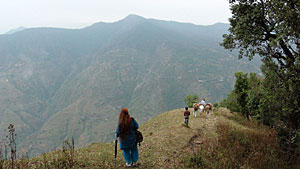 On our way back down from the summit, we paused for one last view of the spectacular panorama. I didn’t want to leave this magical place. I knew that this was the closest I’d ever come to experiencing Shangri-la and I wanted to stay there, breath the fresh prana, meditate and feel blissful peace permeate every cell of my body.
On our way back down from the summit, we paused for one last view of the spectacular panorama. I didn’t want to leave this magical place. I knew that this was the closest I’d ever come to experiencing Shangri-la and I wanted to stay there, breath the fresh prana, meditate and feel blissful peace permeate every cell of my body.
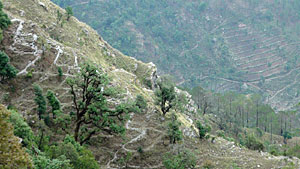 Across the valley we could see five caves where yogis have lived and meditated for ages. These caves are not easy to reach, which is why the yogis live there. They are too difficult to reach so people won’t bother them. You have to climb down a steep slope on narrow animal trails. Caves like these are storehouses of spiritual energy. The divine vibrations that great masters emanate by sitting in samadhi, engaging in sadhana, repeating sacred mantras and performing tapas, permeate these places with tremendous spiritual energy. In addition, great mahatmas and siddhas, not in the body, stay in places like this and can bless sincere spiritual aspirants. I decided that soon I would return to do a retreat in one of those caves.
Across the valley we could see five caves where yogis have lived and meditated for ages. These caves are not easy to reach, which is why the yogis live there. They are too difficult to reach so people won’t bother them. You have to climb down a steep slope on narrow animal trails. Caves like these are storehouses of spiritual energy. The divine vibrations that great masters emanate by sitting in samadhi, engaging in sadhana, repeating sacred mantras and performing tapas, permeate these places with tremendous spiritual energy. In addition, great mahatmas and siddhas, not in the body, stay in places like this and can bless sincere spiritual aspirants. I decided that soon I would return to do a retreat in one of those caves.
As we walked down the mountain, we thought of how much we’d like to return to this sacred place and spend time meditating there. We decided to return each year in the end of October and the beginning of November, which is the time of year when the weather is best, after the monsoons and before winter starts. We’ll bring a few friends (5 to 10) who are sincere spiritual seekers and who are in good physical shape, with no health problems. This will not be a vacation for tourists. It will be a wilderness retreat for serious spiritual practice in silence. If you are interested, email us at gongatara@gmail.com. There will be no charge for this pilgrimage to the Land of the Siddhas. It’s a gift of love. If your heart speaks to you, and you’d like to help the mountain people, you can make a voluntary donation toward building the hospital and school and renovating the kutir. May all beings swiftly attain full enlightenment. Om shanti, shanti, shanti.














Speak Your Mind